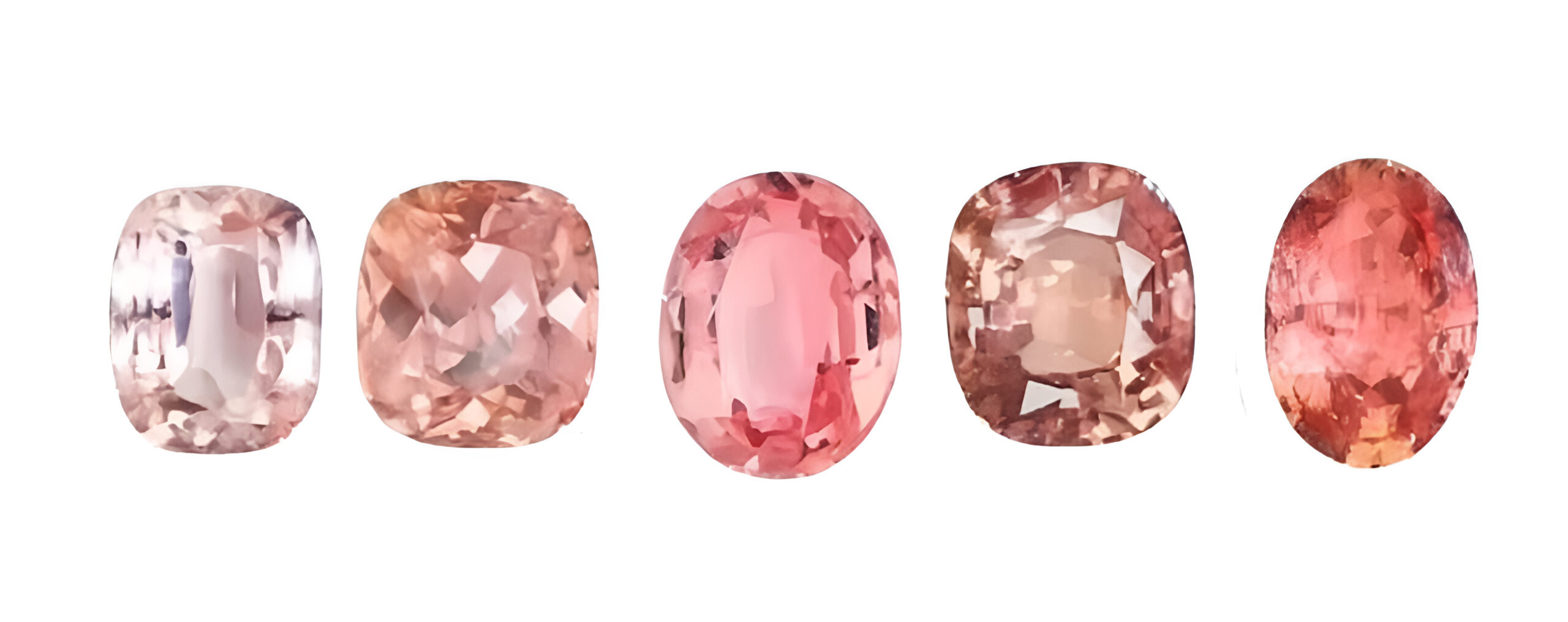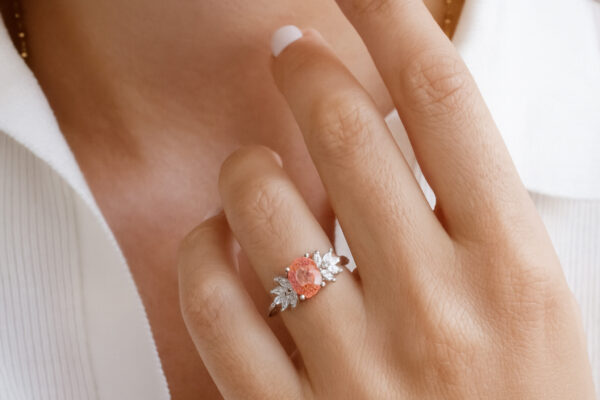
30 Jul 2025 — by Flawless Fine Jewellery — Reading time 3 minutes
Padparadscha Sapphire: Everything You Need to Know Before You Buy
Padparadscha Sapphire: Everything You Need to Know
Padparadscha Sapphire: Everything You Need to Know Before You Buy
Holding the dignity of being among the rarest types of sapphires, Padparadscha sapphires are spectacular. Most people haven’t heard of them, but once known, they melt everyone’s heart away with their glorious appearance.
It has striking beauty and an elegant mix of pink and orange that’s hard to find in any other gemstone. Colors of the gems are finely magical and remind us of sunsets, lotus flowers, or tropical fruits. Even the word “Padparadscha” comes from an old Sanskrit term that describes the color of a tropical lotus flower. Because of their rare color and natural charm, these sapphires have no real match among other gemstones.
Here is a detailed buying guide that you must keep in mind before investing your precious penny in Padparadscha sapphire

Topics covered:
- Padparadscha Sapphires in 2025: Rare, Radiant, and Right on Trend
- What Defines a Padparadscha Sapphire?
- Why the Cut Matters in Making Padparadscha Sapphires Shine?
- Words On the Availability of Padparadscha Sapphire
- Where To Look For Real Padparascha Sapphires?
- The Most Elegant And Rare Sapphire
- Buying Guide of Padparadscha Sapphire
- The Final Thoughts
- FAQ's
Padparadscha Sapphires in 2025: Rare, Radiant, and Right on Trend
Gaining more and more popularity in recent years, Padparadscha Sapphires’ charm is expected to grow stronger in 2025. These glorious gemstones came into the limelight just after Princess Eugenie got engaged in 2018 and holds a stunning flower-shaped padparadscha sapphire ring as an engagement ornament. Since this gemstone is stealing hearts and making more and more people fall in love with its rare but glamorous look. Its dreamy pink-orange colour can be one of the reasons for its popularity, but it’s hard to find a feature that makes it more demanding.
Those in search of something different, especially when exploring that once-in-a-lifetime special engagement ring. From warm-toned metals like rose gold to their sunset-like glow, its admirable traits and characteristics are countless. Also, with the ever-growing trend of rose gold, padparadscha sapphire rings continue to be in the spotlight, with no surprise in 2025.

What Defines a Padparadscha Sapphire?
Inspired by the Sinhalese name for a lotus flower, Padparadscha Sapphire is rare to find and flaunts its charming salmon color. With the perfect hue tone of pink and orange, this gemstone always captures visitors’ attention without any scream or effort. Some even have zones of pink and yellow instead of one even shade, which makes each stone sparkling and eye-catching. These gemstones are still unknown to many, but real gem lovers are totally aware of their value. Although no set of bars decides if it is a true padparascha or not, debates are still going on about this matter. This lack of a set standard only adds to the mystery and allure of this rare gem.
Why the Cut Matters in Making Padparadscha Sapphires Shine?
As these gems are tinted with a lighter shade, if there is any cloudiness or flaw, it will surely make them look dull. Which is not good, and one of the reasons that cut matters a lot when it comes to design Padparadscha sapphires. But, it’s rare to find a character that makes the people go with the strong color rather than perfect clarity. As the rough stones are limited, cutters give it a try to save every bit and don’t let any uneven or unusual shapes happen.
But here is some good news: a smart move can make a big difference. This is called a halo cut. In this process, a small diamond encircles the main stone and offers extra sparkle that perfectly dazzles with sapphire’s true colors. And the hack is that it works well with every shape.

Words On the Availability of Padparadscha Sapphire
Padparadscha sapphires are extremely rare, and because they are so valuable, many treated padparadscha sapphires have been produced to replicate their color. In the late nineties, the market experienced a large influx of sapphires that appeared to be padparadscha. Unfortunately, the excitement did not last long as it was discovered that these gems had been colored artificially with a new process to obtain the unique color of padparadscha sapphires.
By heating pink sapphires with beryllium, the color of the sapphire can change to a beautiful pink-orange reminiscent of a true padparadscha sapphire. This treatment goes deep into the stone and is difficult to identify; however, experts now have reliable methods of gold testing sapphires to tell them apart again.
Where To Look For Real Padparascha Sapphires?
Padparadscha sapphires primarily come from Sri Lanka but also from Madagascar and Tanzania. Some purists state that true padparadschas can only come from Sri Lanka, as it was the only location for many centuries. We believe that the finest stones do derive from Sri Lanka, but Madagascar is currently supplying a significant percentage of all sapphires available on the current market.
The stones from Madagascar are generally more pink than orange, and are a stunning and very good addition to the overall padparadscha supply.
The Most Elegant And Rare Sapphire
Known as one of the rarest and most stunning gemstones, Padparadscha Sapphire comes from the corundum family. Flaunting its eye-inspiring pink and orange charm, just like the lotus flower, these gems’ origin sources are Sri Lanka. Hence, also holds the dignity of being called Sri Lankan Padparadscha Sapphire. The lotus, a symbol of health, longevity, honor, and good fortune, lends more than just color inspiration; it infuses the stone with spiritual and cultural depth.
Its composition has traces of chromium and iron, also called aluminum oxide, contributing to its majestic glow. While Sri Lanka is the original and most famous source of Padparadscha sapphires, these gems are also found in Madagascar, Tanzania, and Vietnam.
Buying Guide of Padparadscha Sapphire
Looking for the best deal on Padparadscha Sapphire price, there is more to overlook before investing that savings of yours. Take a look at this quick buying guide and make your purchase worthwhile:
1. Look for its Pinkish-Orange Allure
The enchanting pinkish-orange color of this gemstone is high in demand and is among its most captivating features. However, there is a huge variety of colors, some might highlight pink over orange while others may have an orange tint higher than pink. So, look out for some hints to identify the originals.
How? The key combination to refer to is HTS: Hue, Tone and Saturation. Look for vibrant orange with a tint of pink having medium tone and higher saturation to get the best value for your money as well as the perfect ornament to add to your collection.
2. Inclusion-Free Rare Sapphires
It’s a common myth that high-quality gemstones are completely free of inclusions. In reality, even the rare and delicate Padparadscha sapphire often contains natural inclusions. Because these sapphires are so rare, finding one with perfect clarity is even rarer.
When selecting your gem, transparency matters. Look for stones where inclusions are minimal and don’t affect the overall brilliance or beauty.
3. Natural Padparadscha Vs Pink Sapphire (Difference)
Some shops may charge the Padparadscha price and sell you pink sapphires. Be aware and inspect the color carefully as it is the only source to identify the difference. Real Padaparajah even with the higher pink shade will surely have a trace of orange tint. On the other hand, pink Sapphire will have either pink or purple fusion. So, don’t let them charge for nothing.
4. Cut can Add More Value
Padparadscha sapphires can be shaped into ovals, rounds, pears, and more. A good cut brings out the gem’s color, clarity, and sparkle. Well-cut stones reflect more light, making them shine beautifully. Set in a metal band, they make stunning and unforgettable engagement rings. Even can make its value double.
5. Carat Weight
Yes, Natural Padparadscha Sapphire is also charged as per its carat weight. But the hack is that it is extremely rare to find this gemstone in high carat. When buying the stone, it is among the more crucial factors to consider before paying that huge amount. Carat weight can also affect its quality, shine, hue and transparency.
Pro tip: 1-carat sizes can vary between $2000 and $10,000 in wholesale.
6. Keep an Eye on synthetic sapphires
Synthetic sapphires are also found in the market, made using methods like hydrothermal, floating zone, and the Czochralski process. These lab-grown stones may look similar but don’t hold the same value as natural ones. So, don’t let this crucial factor slide away from your checklist.
7. Treatment
There are many practices followed by gem retailers to convert pink sapphires into a Padparadscha-like color. Lattice diffusion or beryllium diffusion are the most common among them. So, before paying the bill for real sapphire, it will be wiser to take the help of a gemologist and check whether it is a rare gem or just another beryllium-treated one.
8. Certification
Always buy from a trusted dealer who offers certification from a recognized gemological lab such as GIA, AGL, SSEF, or Gübelin. These certificates give an expert, unbiased assessment of the gem’s quality, including its color, cut, and clarity. So, you can buy with confidence.
9. Price
Natural Padparadscha sapphires are among the rarest and most sought-after gemstones in the world. Prized by collectors, they’re quickly snapped up when found. Their value depends on size, color, clarity, and treatment, with unheated gems being the most valuable. Due to their rarity and beauty, Padparadscha are not just gems, they’re exceptional investments and cherished additions to any fine jewelry collection.
The Final Thoughts
Owning a Padparadscha sapphire is like holding a piece of sunrise, rare, radiant, and deeply meaningful. Before paying that saving of yours, it is important to tick all the factors that are crucial to buying an original gemstone in your valuable collection. You can refer to all the above-given points to get the best value for the money.
FAQ’s
How to tell if a Padparadscha Sapphire is real?
To tell if a Padparadscha sapphire is real, check for a balanced pink-orange hue and request certification from a trusted gemological lab like GIA or AGL.
Avoid stones with overly vivid or uneven color, which may indicate treatment or imitation.
Are padparadscha sapphires valuable?
Yes, Padparadscha sapphires are very valuable because they are extremely rare and have a unique pink-orange color.
Unheated and high-quality stones can sell for thousands of dollars per carat.
How much does a Padparadscha Sapphire cost?Padparadscha sapphires can cost anywhere from \$2,000 to over \$10,000 per carat, depending on their quality, size, and whether they are untreated. Rarer stones with better color and clarity are more expensive.
What is the rarest sapphire color?
The rarest sapphire color is the pink-orange shade of the Padparadscha sapphire. Its unique mix of colors makes it highly prized and hard to find.
What is the difference between sapphire and Padparadscha?
Sapphire comes in many colors, but Padparadscha is a rare type with a unique pink-orange hue. It’s one of the most valuable and uncommon varieties of sapphire.

